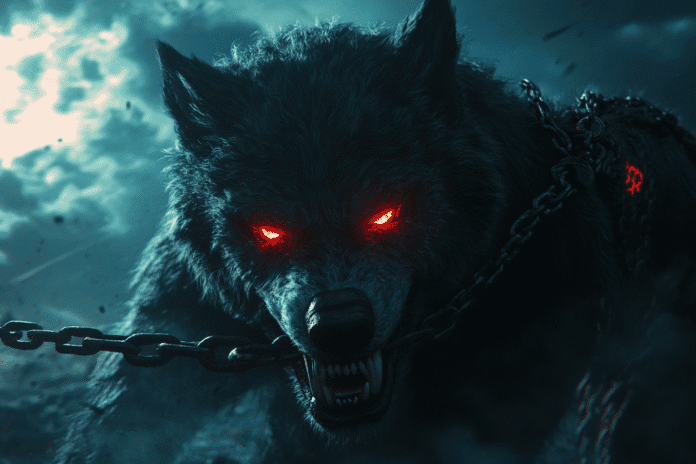Who Is Fenrir?
Fenrir is one of the most famous and terrifying legendary creatures in Norse mythology. A giant wolf, he is the son of the trickster god Loki and the giantess Angrboda. Fenrir appears in many ancient Norse texts such as the Poetic Edda and Prose Edda. He is not only a symbol of chaos and destruction but also a central figure in the prophecy of Ragnarök — the end of the world — where he is foretold to devour Odin, the chief god of the Norse pantheon.
More than just a monstrous being, Fenrir represents untamed, primal forces — wild power that even the gods fear. His image carries deep philosophical meaning about the struggle between order and chaos, freedom and control, divinity and monstrosity.
Fenrir’s Appearance and Traits
Fenrir is depicted as an enormous wolf, towering over all living beings. His eyes blaze like fire, his teeth are sharp as blades, and his roar sounds like thunder. It’s said that when he opens his mouth, his upper jaw touches the sky while the lower jaw scrapes the ground — a vivid metaphor for his boundless strength and capacity for destruction.

In ancient carvings and modern illustrations, Fenrir is often shown in chains, howling in rage, with eyes full of fury. The magical chain that binds him — called Gleipnir — was made from impossible elements: the roots of mountains, the sound of a cat’s footsteps, the sinews of a bear, a fish’s breath, and a bird’s spit. This symbolizes that only the unimaginable could restrain such a force.
Origins and Symbolism of Fenrir
Fenrir is the offspring of Loki — the god of mischief — and Angrboda, a giantess from Jotunheim. From the moment of his birth, the gods foresaw that Fenrir would pose a great threat to the world. To prevent the prophecy of Ragnarök — in which Fenrir would break his chains, kill Odin, and plunge the world into chaos — the gods decided to bind him.
Symbolically, Fenrir represents raw, untamed nature, rebellion, and repressed anger. In Norse culture, wolves already symbolized relentless brutality and predatory instinct — but Fenrir surpasses these traits. He becomes the ultimate embodiment of vengeance and the inevitability of fate.
Fenrir’s Power and Physical Might
Not only is Fenrir massive, but his strength surpasses that of all living beings. He grew so powerful so quickly that the gods resorted to trickery to imprison him. Though bound by Gleipnir — a magical chain — Fenrir never truly submitted.
When Ragnarök arrives, Fenrir will break free from his chains and open his jaws wide to devour Odin, the ruler of Asgard. This moment marks more than just the triumph of a beast — it symbolizes the unstoppable nature of destiny.
Beyond his physical might, Fenrir also stands for revolutionary power and defiance against divine authority. This is why he’s not merely a “monster,” but a symbol with deep philosophical weight.
Famous Myths and Legends About Fenrir
One of the most powerful stories about Fenrir is the gods’ attempt to chain him. After failing twice, they turned to the dwarves — masters of magical craftsmanship — who forged the unbreakable Gleipnir. To gain Fenrir’s trust, the war god Tyr placed his hand in the wolf’s mouth as a sign of faith. When Fenrir realized he had been tricked, he bit off Tyr’s hand.
This tale is one of the most emotional and tragic moments in Norse mythology — where bravery, trust, and sacrifice intersect. Fenrir may be the enemy, but he is not purely evil — his actions reflect the injustice he suffered at the hands of the gods.
Fenrir’s Influence in Modern Culture
Fenrir has inspired countless works in modern culture — from comics and movies to video games. In the Marvel universe, Loki and his descendants, including Fenrir, are reimagined based on Norse legends. In God of War: Ragnarök, Fenrir is portrayed as a deeply emotional character with a tragic backstory.
The image of a chained giant wolf also frequently appears in fantasy novels, Japanese manga, and gothic art — often as a symbol of suppressed power, a desire for freedom, and rebellion against fate.
Similar or Opposing Mythical Creatures
Fenrir can be compared to Cerberus in Greek mythology — another giant canine that guards the underworld. However, unlike Cerberus who merely guards a gate, Fenrir challenges the entire cosmic order.
On the opposite end is Sleipnir — Odin’s eight-legged horse and Fenrir’s half-brother. While Fenrir stands for chaos and rebellion, Sleipnir represents speed, wisdom, and loyalty to divine order.

Fenrir in Feng Shui and Symbolic Use
Although not a traditional figure in Eastern feng shui, Fenrir has found symbolic relevance in modern interpretations. He can be seen as a guardian symbol, representing strength, resistance to injustice, and courage.
Statues or artwork of Fenrir are often placed in creative or rebellious spaces, encouraging resilience and the courage to overcome adversity. However, due to his intense and confrontational symbolism, he may not be suitable for peaceful or neutral environments.
Conclusion
Fenrir is far more than just a mythical creature — he embodies deep layers of meaning: the injustice of power, the inevitability of fate, the yearning for freedom, and the strength restrained by force. Through the centuries, the image of the giant wolf has remained a powerful symbol of tragedy, strength, and rebellion in human culture.
Fenrir reminds us that even those labeled as “monsters” have their own reasons, pain, and desires. And sometimes, what’s suppressed for too long may erupt like a tidal wave that nothing can stop.
